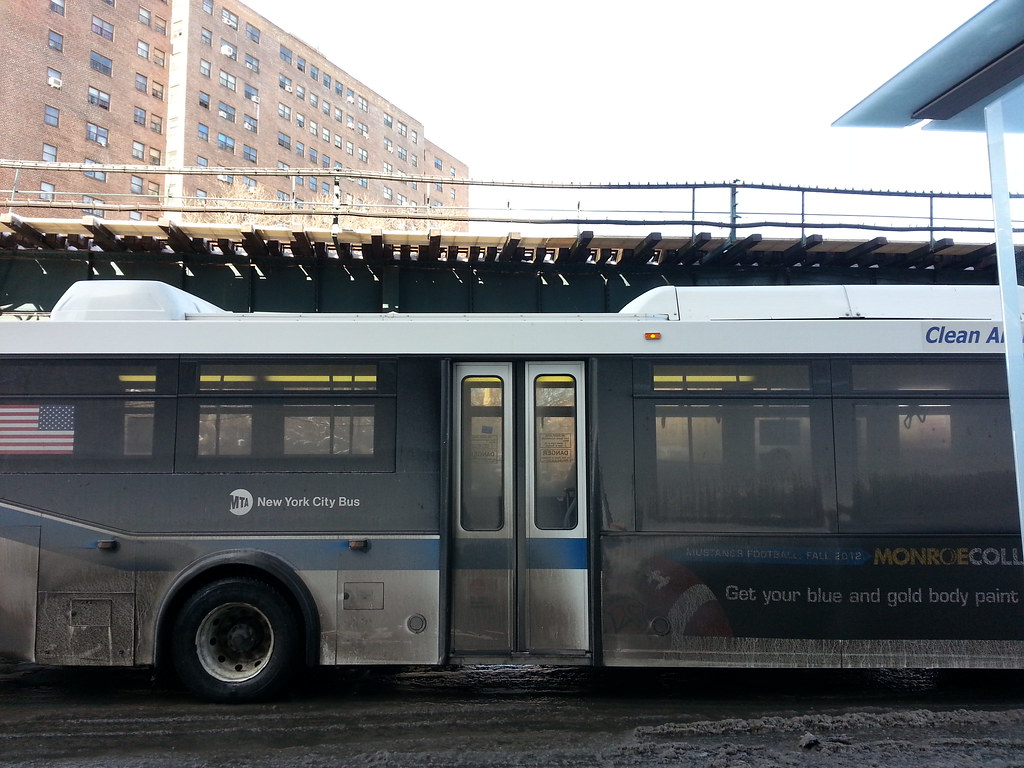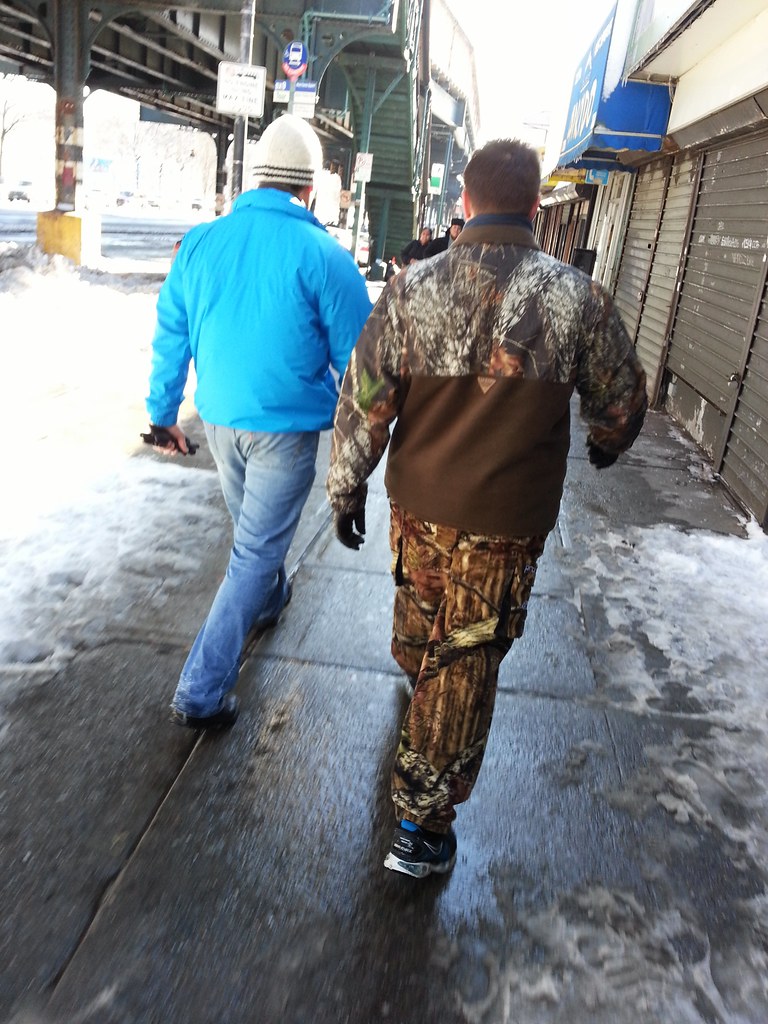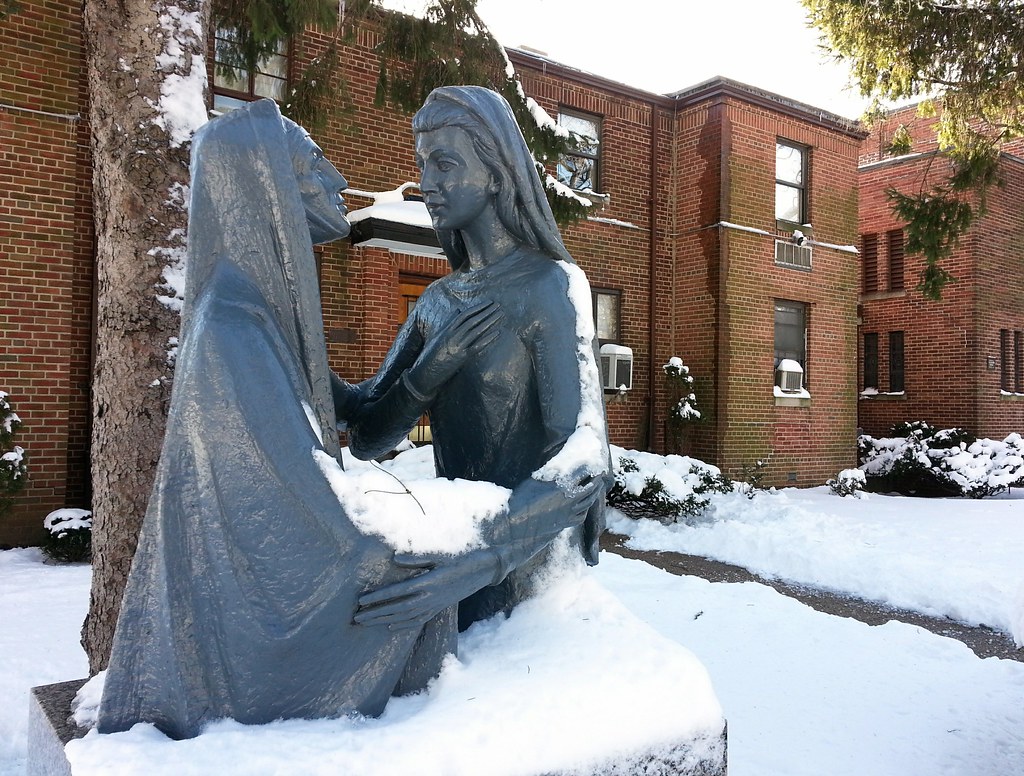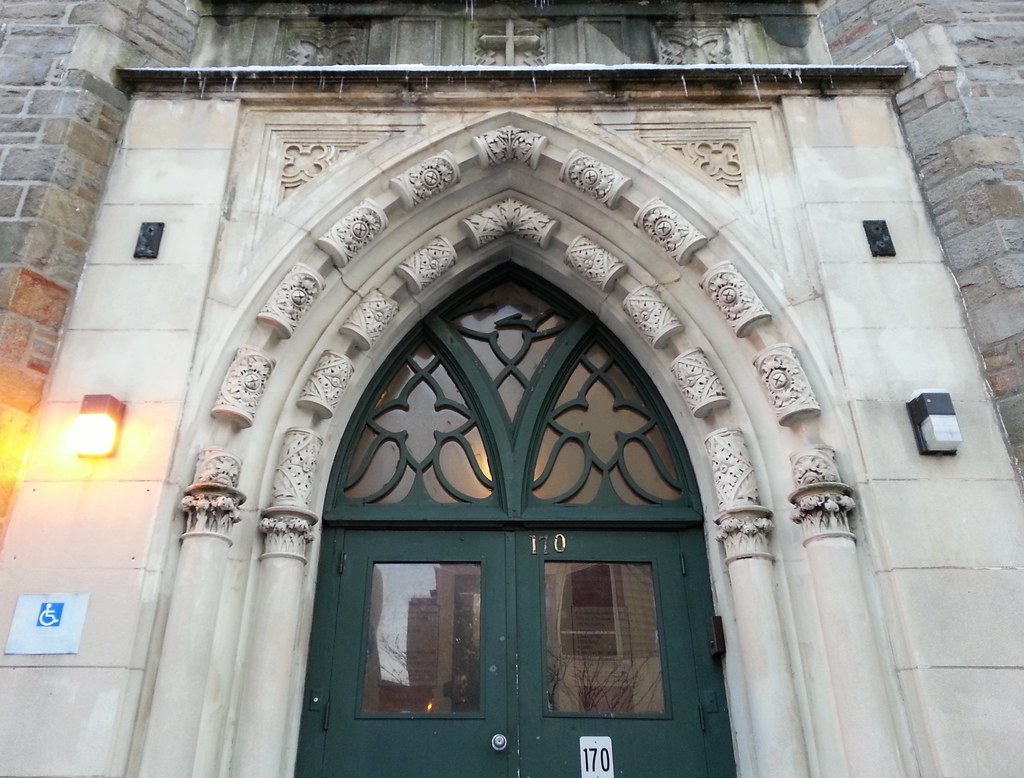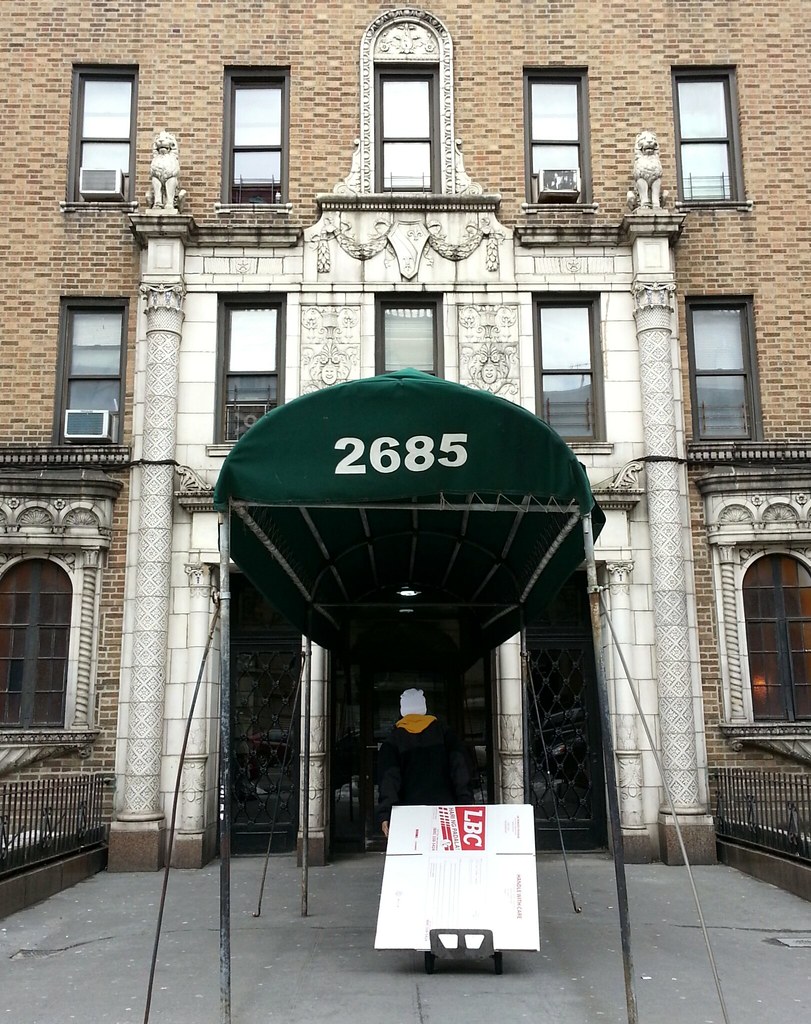
on the site of the old Elmhurst gas tanks

This Wendy's (at 85-07 Queens Boulevard) was the real-life location of the McDowell's restaurant in Coming to America:
Me and the McDonald's people, we... we've got this little... misunderstanding. See, they're MacDonald's. I'm McDowell's. They got the Golden Arches; mine is the Golden Arcs. Now see, they got the Big Mac; I got the Big Mc. We both got two all-beef patties, special sauce, lettuce, cheese, pickles, and onions, but— they use a sesame-seed bun. My buns have no seeds.
(Listen above. Is it just me, or does John Amos sound an awful lot like Barack Obama by the time he gets to the "no seeds" line?)
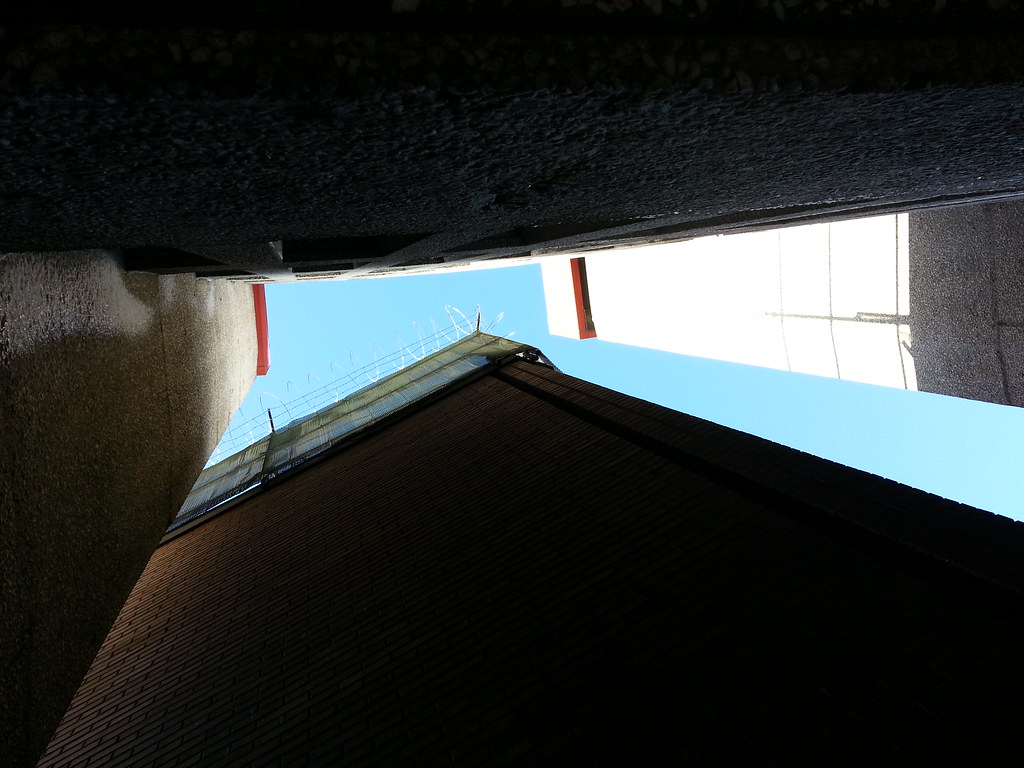
The time has come to retell one of the best stories I've learned so far on this walk. Let's start with an aerial photo of the Queens Place mall. A nice big circle, right? Not quite.
The mall was originally an enormous Macy's department store that opened in 1965. Two years earlier, Macy's began buying up all the land on the irregularly shaped five-acre block where the mall now sits. Everyone sold out except for one little old lady, a widow by the name of Mary Sendek (or Sondek, depending on your source), who lived at the corner of Queens Boulevard and 55th Avenue. The proposed layout of the arena-like store called for only a slight intrusion into her backyard, but rather than shrink the circle by a few feet, Macy's decided to start building the original design, assuming she was just holding out for more money and could be bought off before the construction reached her property.
Macy's offered as much as $200,000, but Ms. Sendek refused to budge. She apparently had a dog she was very fond of, and didn't want to deprive him of the spacious backyard he so enjoyed. Or maybe, as one of her neighbors said: "She was young when she came and started life here, and she figured she wanted to leave life here. Their money didn't mean anything." Whatever her reasons, Macy's was forced to cut a little notch out of their otherwise perfect circle (take a closer look at that aerial photo) to skirt the edge of her backyard. Here's a great photo of her house standing alone against the immense, indented facade of the store.
Ms. Sendek died some years later; her house was knocked down and a strip mall built in its place. (As you can see here and in the photo above, it takes up the full extent of the lot, all the way into the notch in the wall.) Macy's hung around a while longer, but eventually departed for the greener pastures of the nearby Queens Center mall. The giant, flawed cylinder they erected endures, however, as a monumental geometric record of one woman's immovable personality.
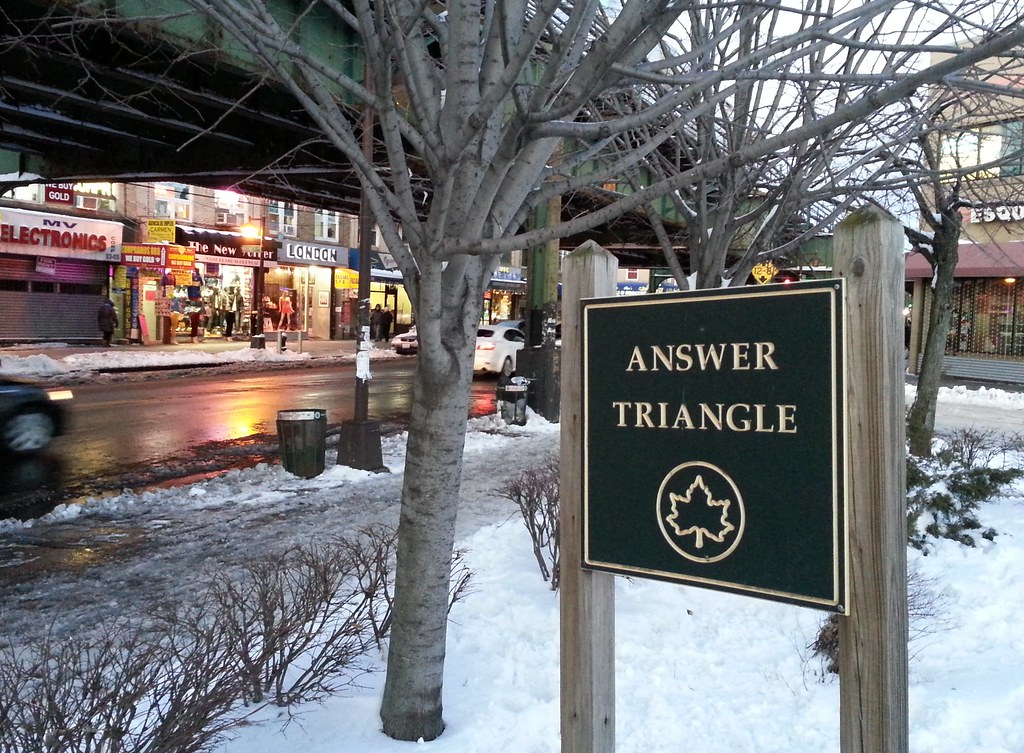
A classic Henry Stern park name. According to the Parks Department's website:
Answer Triangle draws its name from a play on words with the street on which it is located. The park is on Aske Street, and the response if one were to “ask(e)” a question is an “answer.”

Edgar Allan Poe's Bronx cottage: a house for all seasons

to the massive, castellated Kingsbridge Armory. This vast structure, built around a century ago to house the National Guard's Eighth Coastal Artillery Regiment, has been vacant for almost 20 years now, but maybe not for much longer — national ice center, anyone?

Built into the side of a hill, this strange little enclave looks like it may have originally been a series of garages.
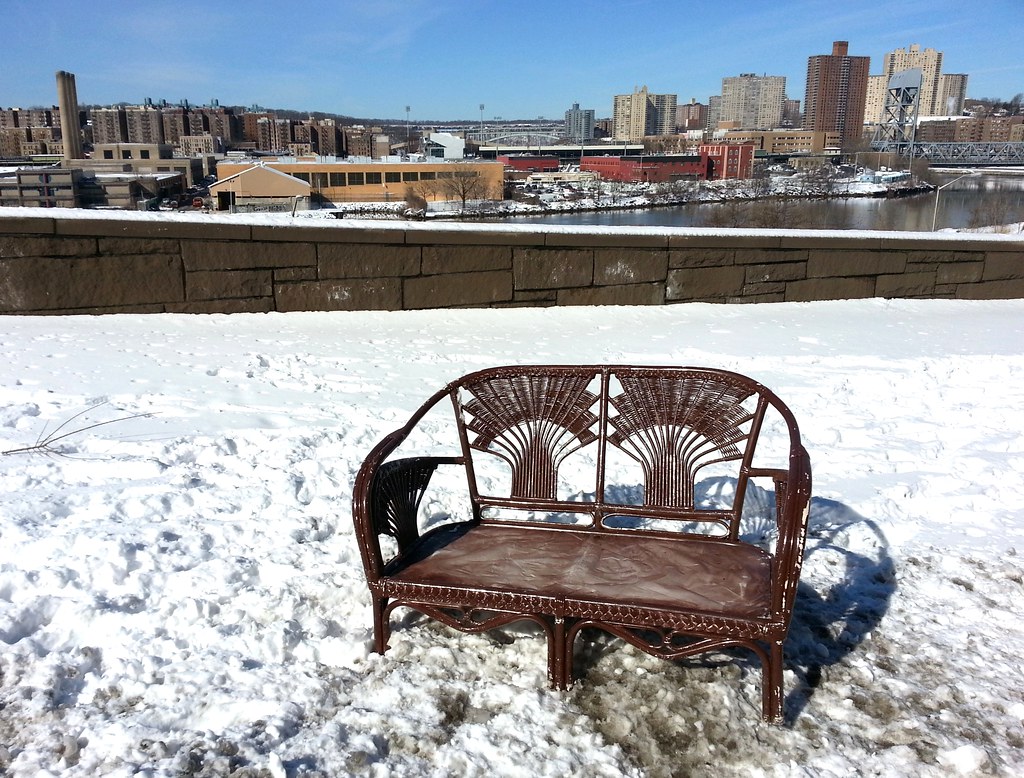
Although the view's better facing this way. Looking out over the Harlem River (that's Manhattan on the other side), you can see a few old acquaintances of ours. From left to right, we have the defunct Inwood incinerator stacks, the Henry Hudson Bridge (you might need a close-up to find it in the background), the Promenade Apartments, and the Broadway Bridge.

It's worth taking a closer look at the names on the bottles. I think my favorite is Dragon Blod.

According to its plaque, this statue memorializes the first coyote confirmed to have been seen in New York City since 1946, a female found dead in 1995 on the Major Deegan Expressway, which passes through the park (although it turns out that, unbeknownst to the Parks Department at the time, another coyote had been spotted in nearby Woodlawn Cemetery in 1994). There is now an established population of the canids in the Bronx — it's said that they particularly enjoy hanging around the golf course here at Van Cortlandt Park — and every once in a while, one will even make an appearance in Manhattan. A local scientist has enlisted students from the High School for Environmental Studies to help him set up camera traps around the city's parks to track the animals' growing presence — here's one of their shots.

Once the site of a village built by the Wiechquaeskeck (or Wickquasgeck, or Weckquaesgeek) tribe, this expansive field acquired its name from its use as a National Guard parade ground during the late 19th and early 20th centuries. It became a temporary home for 15 bison in 1907 (not the first time such creatures were kept at Van Cortlandt Park), and, along with the rest of the park, served as an Army training facility during World War I. Turned into a full-fledged recreation area in 1938, the recently reconstructed Parade Ground now contains, beneath all that snow, ten cricket pitches, six soccer fields, two baseball diamonds, two softball diamonds, and a 1.5-mile running path.
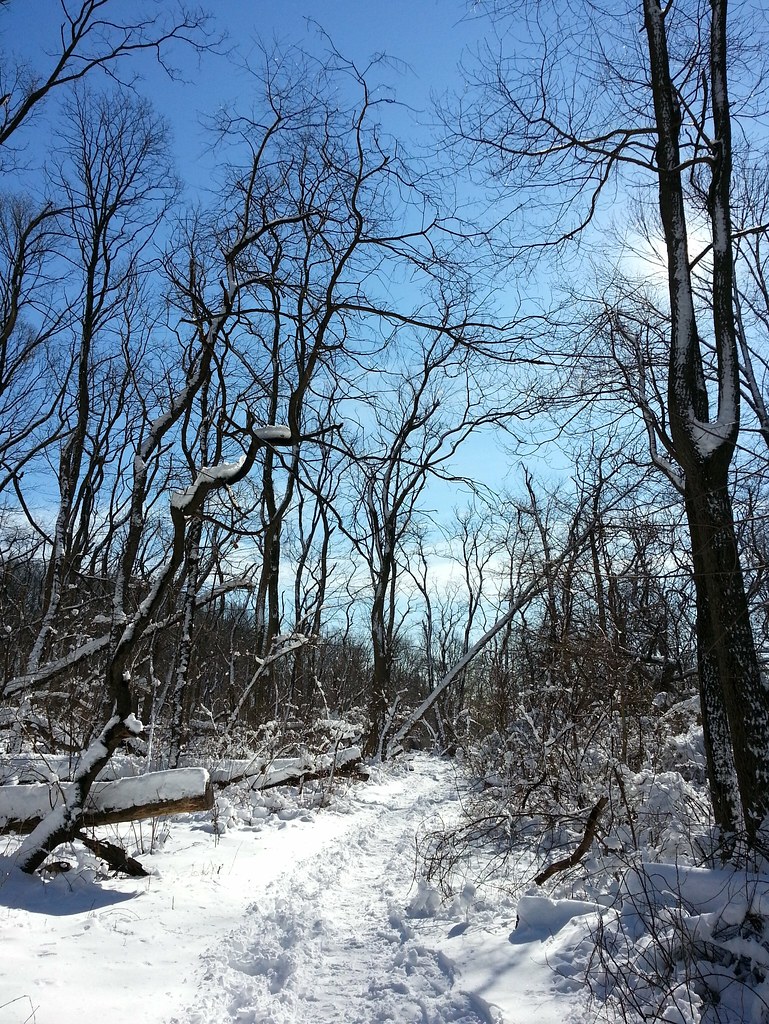
Following the course of the Old Put's Getty Square branch
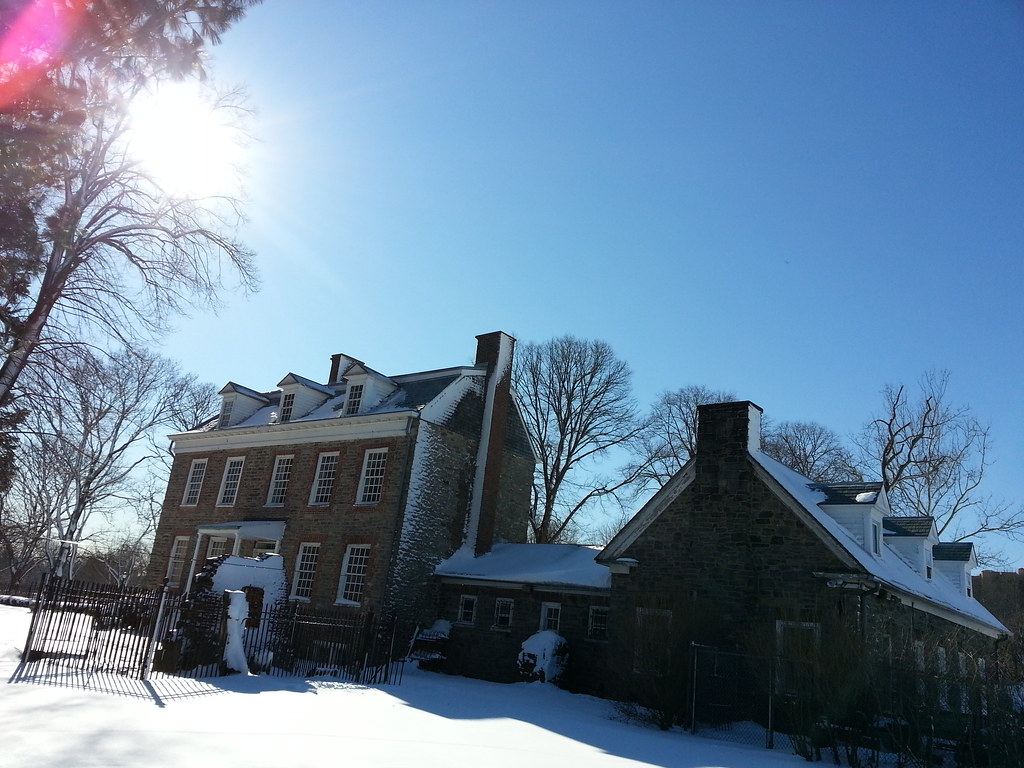
Built in 1748-49, this* is the oldest house in the Bronx, and "was the scene of military maneuvers and intrigue" during the Revolutionary War. Here are some great photos of the well-maintained interior, which has served as a museum of 18th-century life since 1896.
* The L-shaped structure on the left is the original house. You can't tell it's L-shaped in this photo, though. This bird's-eye view and this photo of the front of the house should make things a bit clearer.

This gateway once led down to the sunken Colonial Garden, a formal garden surrounded on three sides by canals, designed by Samuel Parsons Jr. (of the Flushing horticulturalist Parsons) around the turn of the 20th century as a complement to the nearby Van Cortlandt House (located behind me in this photo), which had just been turned into a museum of 18th-century life.
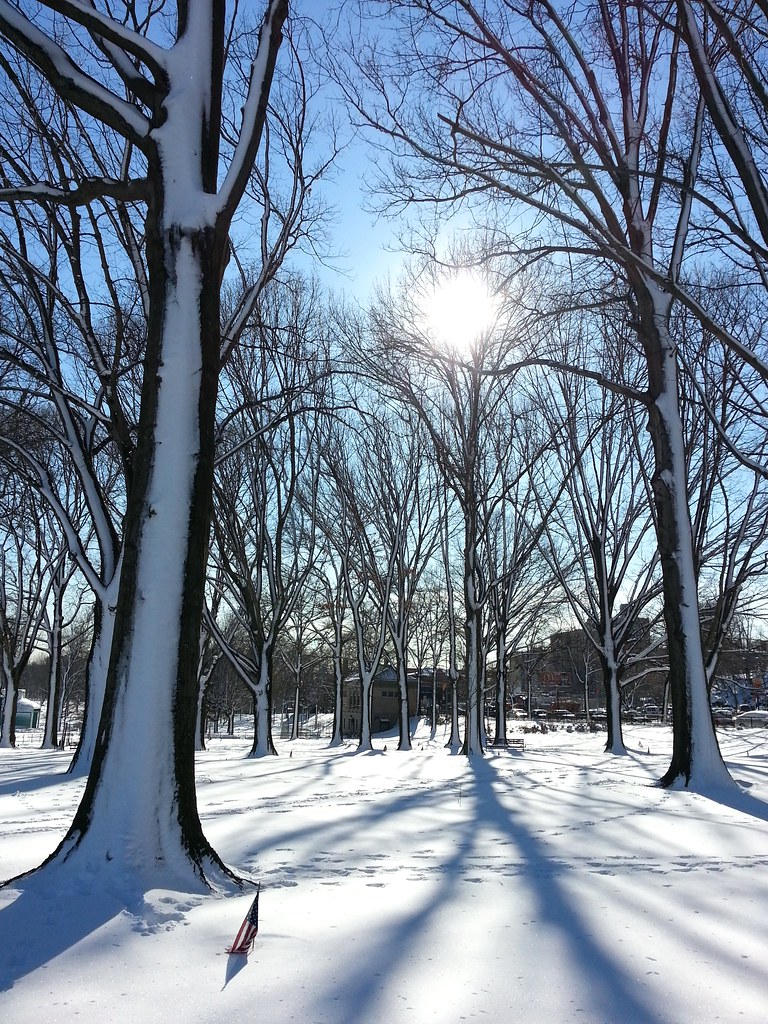
Planted in 1949 and recently renovated after years of neglect
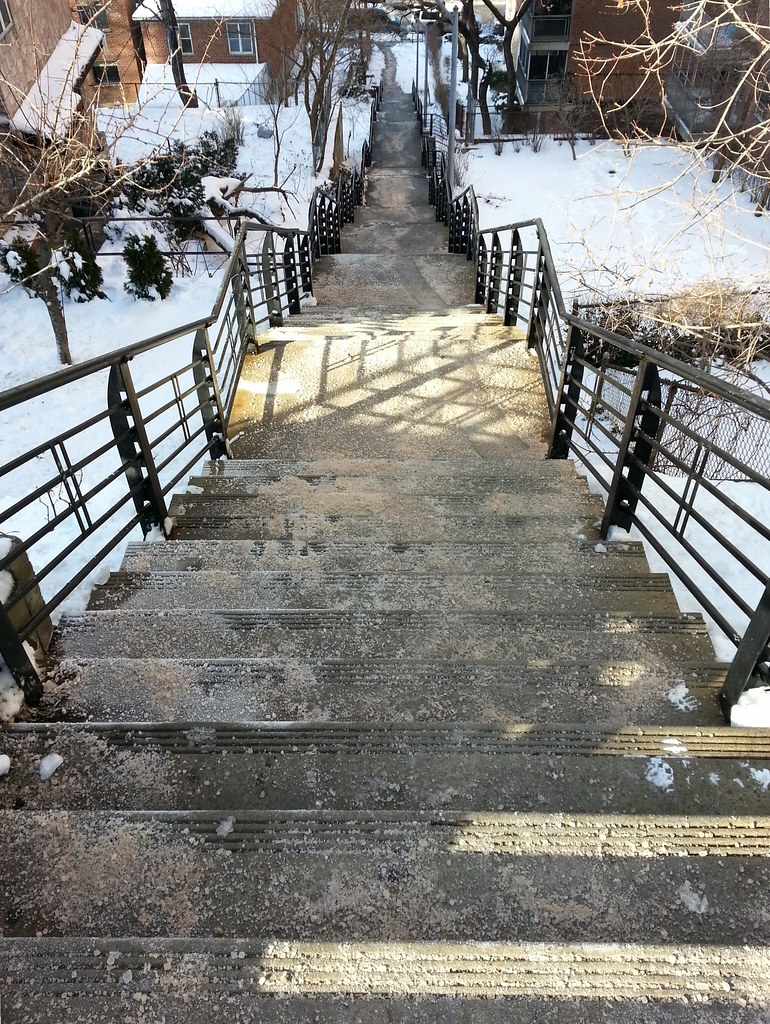
One of the many step streets found on the steep slopes of Kingsbridge Heights

In the early years of the 20th century, when the boys at the New York Central Railroad were planning to build Grand Central Terminal (declared by the NY Times to be "the greatest station, of any type, in the world" when it opened just over 100 years ago), they wanted to test out several different kinds of stone they were considering using for the building's facade. So they lined up 13 pillars* from various quarries here in Van Cortlandt Park beside the rails of the Old Put (which is now a walking trail) and waited to see which one fared best as it weathered. They ended up going with Indiana limestone, although that was apparently just because it was the cheapest to transport.
* Ignore the parts about Cornelius Vanderbilt in the link above; he was long dead by 1900.

on the defunct New York and Putnam Railroad

Turns out they do.
The guy looking at the camera handed me a little flyer as I passed by. It reads, in part:
WE BUY GOLD
AMAZING LINEN CORP.
3481 JEROME AVE. BRONX, NY 10467
INSIDE THE CURTAIN STORE, NEXT TO
THE CITIBANK, ACROSS THE STREET
FROM THE POST OFFICE.

Built around 1758, just a decade after the Van Cortlandt mansion, this sturdy fieldstone structure is the Bronx's second-oldest house. It now serves as the Museum of Bronx History; after being donated to the Bronx County Historical Society in 1965, it was wheeled across the street to this spot on public parkland. (Actually, it was plopped down in the middle of what was then a street, and that section of street was subsequently incorporated into Williamsbridge Oval Park.) A few years later, the amphibious Bronx River Soldier was stationed here, and he's remained ever since.
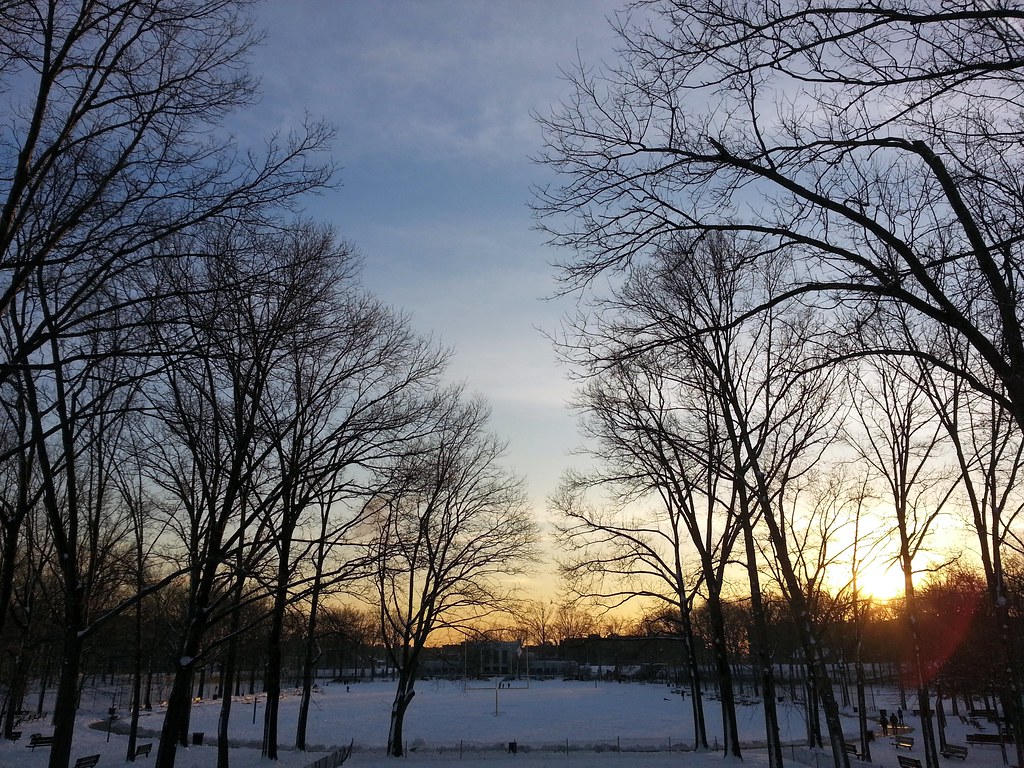
This park sits on top of the former Williamsbridge Reservoir, opened in 1888 to provide water, piped in from the Bronx and Byram Rivers, to the West Bronx, which had just been annexed by New York City in 1874. By 1919, the reservoir was no longer needed and was taken out of service, but it continued to be used as an emergency backup (and unauthorized neighborhood swimming hole) until being drained in 1925.
Robert Moses wanted to turn the site into a massive sports amphitheater with a seating capacity of 100,000, but this plan was shot down by local residents. Instead, the reservoir was partially filled in and converted into a public recreational facility; the opening ceremony in 1937 concluded with a race featuring Glenn Cunningham, the world-class track star who had managed to overcome a horrific childhood accident that left him burned and scarred and unable to walk for many months.
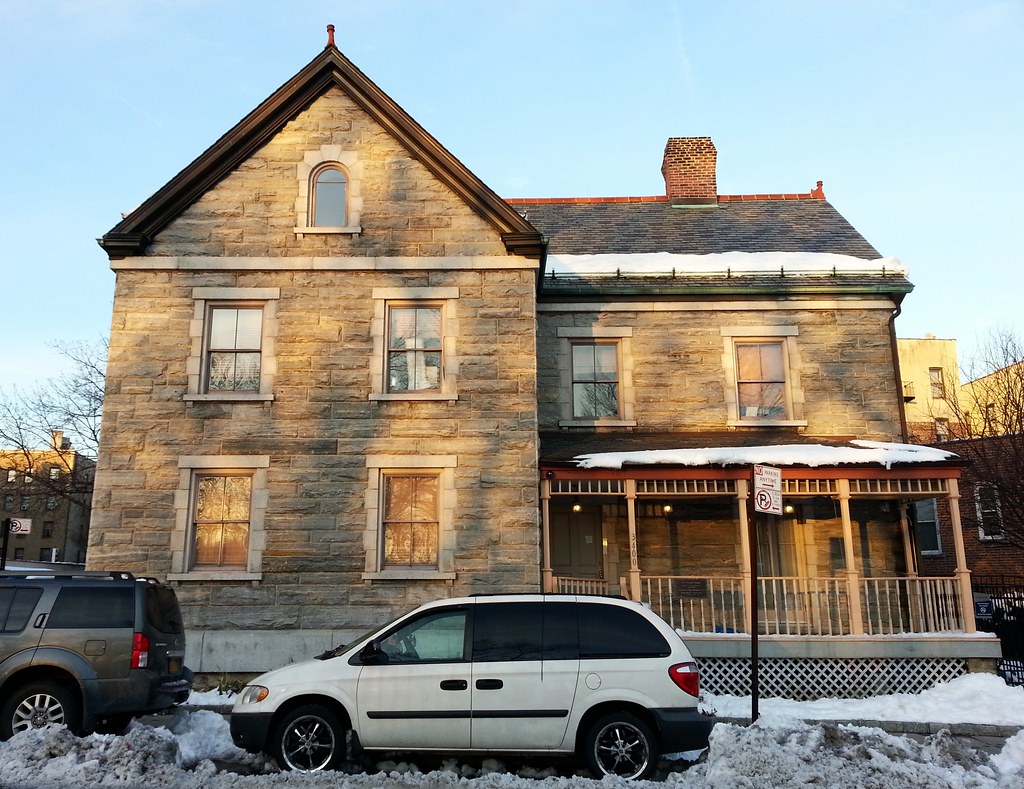
Built in 1889-90 as a residence for the reservoir keeper, this house was bought by Isaac Barkey, a physicist and engineer, in 1946. He constructed a chemical and biological laboratory in the basement, where he conducted his "confidential research", and spent many years trying to shape the structure into the mansion of his dreams. He never succeeded, though, and finally moved out, heartbroken, in 1998, selling the house to the Mosholu Preservation Corporation, which still owns it today.
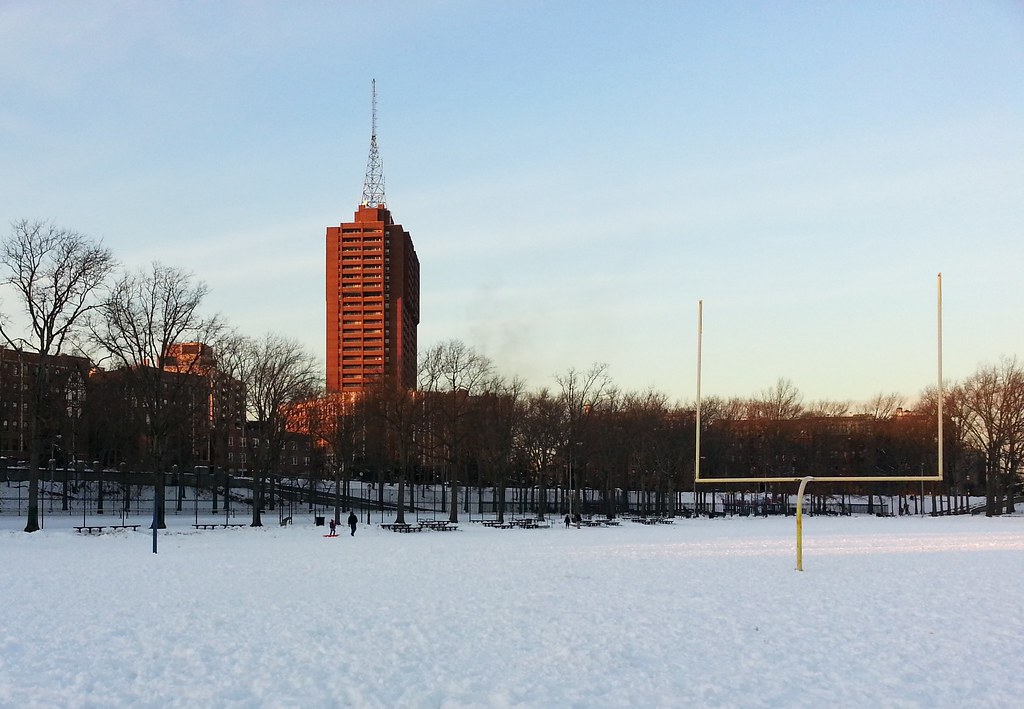
If anyone else out there is a fan of Fordham University's WFUV-FM, you might be interested to know that this is the station's main transmission tower, standing tall atop an apartment building owned by Montefiore Medical Center. The hospital offered to let Fordham locate its antenna on this rooftop in 2004 to resolve a decade-long dispute between the university and its next-door neighbor, the New York Botanical Garden, whose president and chairman were "shocked and deeply disturbed" by the radio tower Fordham had been building on its campus, calling it "a jarring intrusion" on the garden's "magnificent backdrop of unimpeded skyline".

on the property of a building owned, I believe, by Montefiore Medical Center
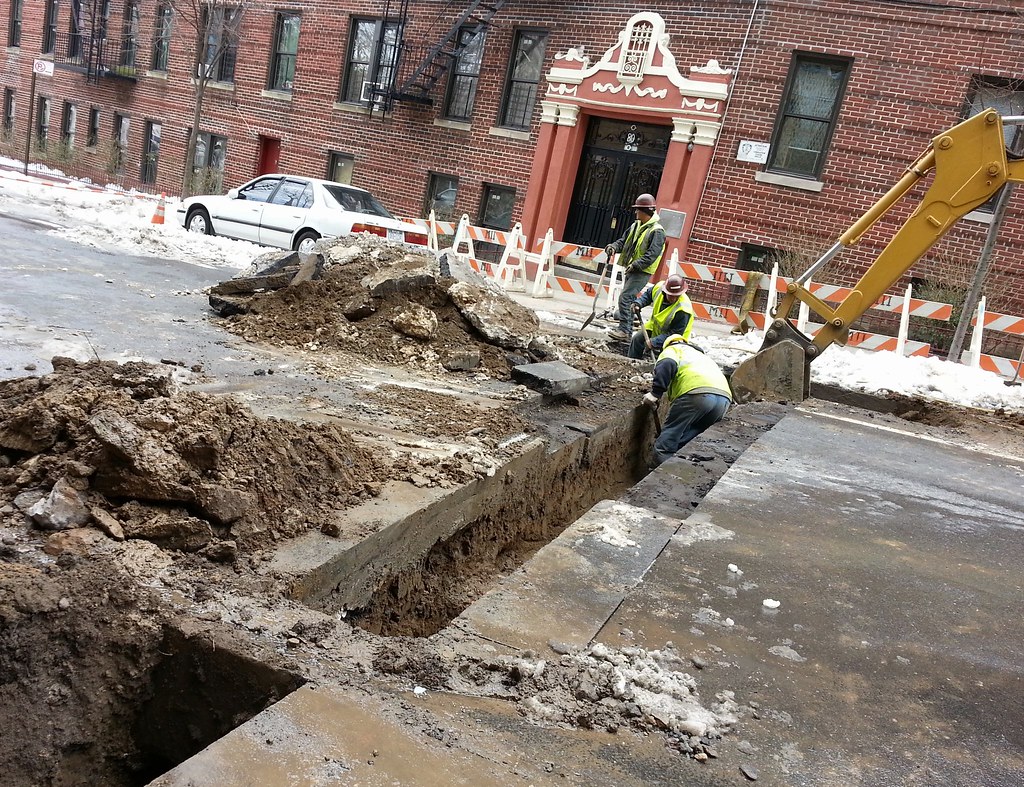
The gutter was left in place to keep water flowing across the cut in the road. Zoom in to see it in action.

Upon this hill stood Fort Number Four, built by the Americans in 1776 and later captured and occupied by the British during the Revolutionary War. The remains of the redoubt were discovered by the amateur archaeologist Reginald Pelham Bolton (the same guy who reconstructed the Hessian hut on the grounds of the Dyckman Farmhouse) sometime around 1910. After being designated as parkland, the site of the old fort was "released from brambles and suitably marked" with this plaque, which was unveiled in 1914 "with appropriate ceremonies".

The former site of Fort Number Four now offers a nice view of the Jerome Park Reservoir.

with the Bronx's tallest buildings looming in the distance

Converted into the Kingsbridge Heights Community Center in 1974-75 by three dedicated women, this building was originally the station house of the NYPD's 50th Precinct. (Actually, it was originally the station house of the 40th Precinct, which later became the 74th, then the 57th, then the 26th, and finally, on August 1st, 1929, the 50th Precinct.)
In the late 1800s, this precinct (then the 35th — isn't this fun?) was headquartered in a dilapidated "shanty"; it was said by one reporter that "no more unhealthier police station exists in the City of New York than this one". An 1898 review by The Real Estate Record and Guide "branded municipal architecture a disgrace" and claimed that "there is not even one architecturally decent police station" in the entire city.
Things were soon to take a turn for the better, however. The city began a campaign to improve its police facilities, and the burgeoning City Beautiful movement was redefining the nature of New York's civic architecture.
The 50th Precinct house was erected in 1901-02, and it's quite an impressive edifice, at least to the eye of this 21st-century pedestrian. At the time of its construction, however, its architects, Arthur Horgan and Vincent Slattery, were widely reviled, seen as talentless nobodies who received commission after commission from Mayor Robert Van Wyck because of their ties to Tammany Hall.
In addition to their design work, Horgan and Slattery were often hired by Van Wyck to consult on the plans of much more respected architects, giving some the impression that their real role was to ensure that the projects were funneling a sufficient amount of money into the pockets of Tammany contractors. In 1899, the NY Times had this to say about the duo, whom few had heard of prior to Van Wyck taking office the year before:
Who are, or what is, "Horgan and Slattery"? . . . Whenever there is a decent and considerate project of architecture involved, Horgan and Slattery are invoked to give the weight of their professional opinion to the proposition that it is "no good."After the municipal reformer Seth Low was elected mayor in 1901, he called for the "dishorganizing and unslatterifying" of city architecture, and sought, with only partial success, to cancel the city's outstanding contracts with the firm. Much to his chagrin, Horgan and Slattery were able to hold on to their highest-profile job, the completion of the Hall of Records (known today as the Surrogate's Courthouse). The mayor supposedly then took another tack, using his influence to throw wrench after wrench into the firm's plans for the Hall. His administration's Art Commission, for example, was known to have repeatedly rejected the proposals of the sculptors that had been hired for the job.
But, then, is their professional opinion any good? Has it any weight? Does anybody know who they are or what they have done or why any human being should pay them a nickel each for their opinions on the art of architecture or even whether they exist? It is of course possible that there are two actual, concrete human beings who call themselves respectively Horgan and Slattery, and who call themselves artchitects. . . .
[But] suppose that, for its own purposes, Tammany had invented an architectural firm which had no corporeal or personal existence, and called it, let us say, Organ and Flattery, and had used it to "hold up" every public building on which the "divvy" was not satisfactory to the organization! What would be the difference? Would not Organ command as large a degree of the public confidence as Horgan, and Flattery as Slattery?
Frustrated by all the setbacks, Horgan and Slattery reportedly came up with a plan to embarrass the Art Commission, which they suspected was blindly shooting down their designs. They had their sculptors submit a new set of plans for the Hall of Records that just happened to consist of careful copies of work by Michelangelo and Leonardo da Vinci — which was then, of course, rejected by the unknowing commissioners. Or, as Slattery himself put it:
It was arranged to submit to the Municipal Art Commission exact reproductions for the cornices of some gargoyles by Michelangelo in St. Peter's at Rome. Many of these drawings were rejected by the Municipal Art Commission as not being up to the standard of their artistic ideas. I won't say much more about the matter just now.Removed from the political acrimony of the time, today's architectural critics seem to have more favorable opinions of Horgan and Slattery. The AIA Guide to New York City calls the 50th Precinct house "a rich Renaissance Revival-Eclectic building", and the Times's Christopher Gray writes that "their work rises far above the hack category into which it is . . . often dumped."
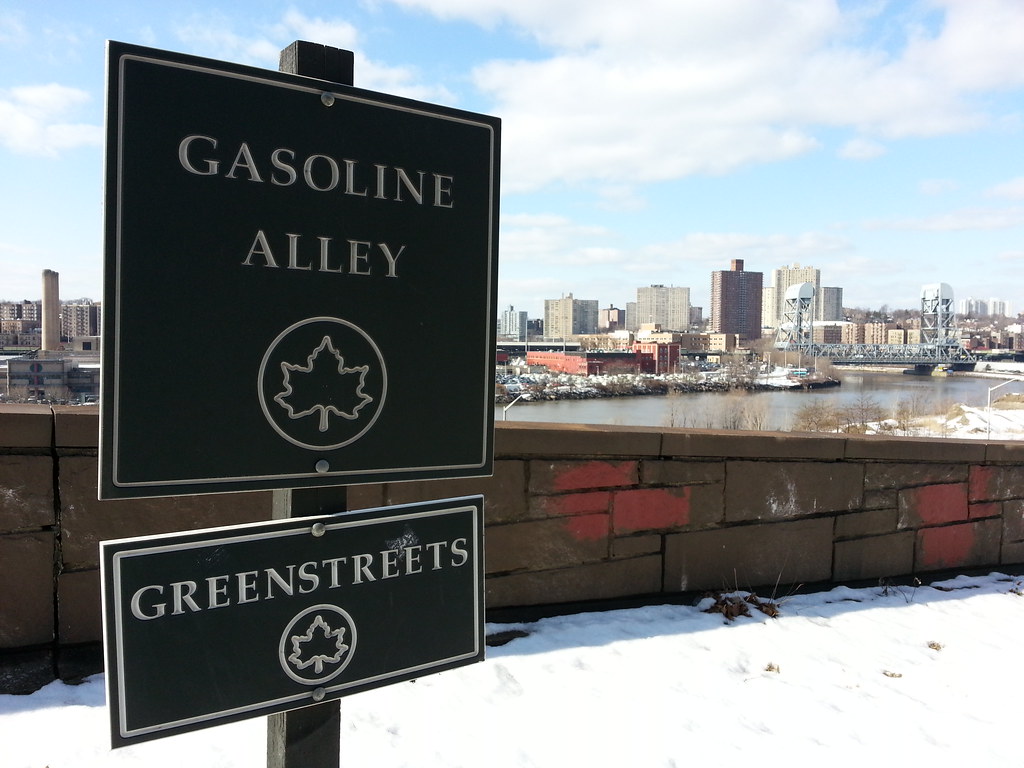
When I first passed this snowy strip two days ago, I somehow failed to notice this sign indicating it is one of the city's most intriguingly named parks. Unfortunately, I can't find any information about the origin of its appellation online. The name is probably a reference to the nearby Major Deegan Expressway (located just on the other side of that brown retaining wall), but I like to imagine it has something to do with those mystery garages located across the street.
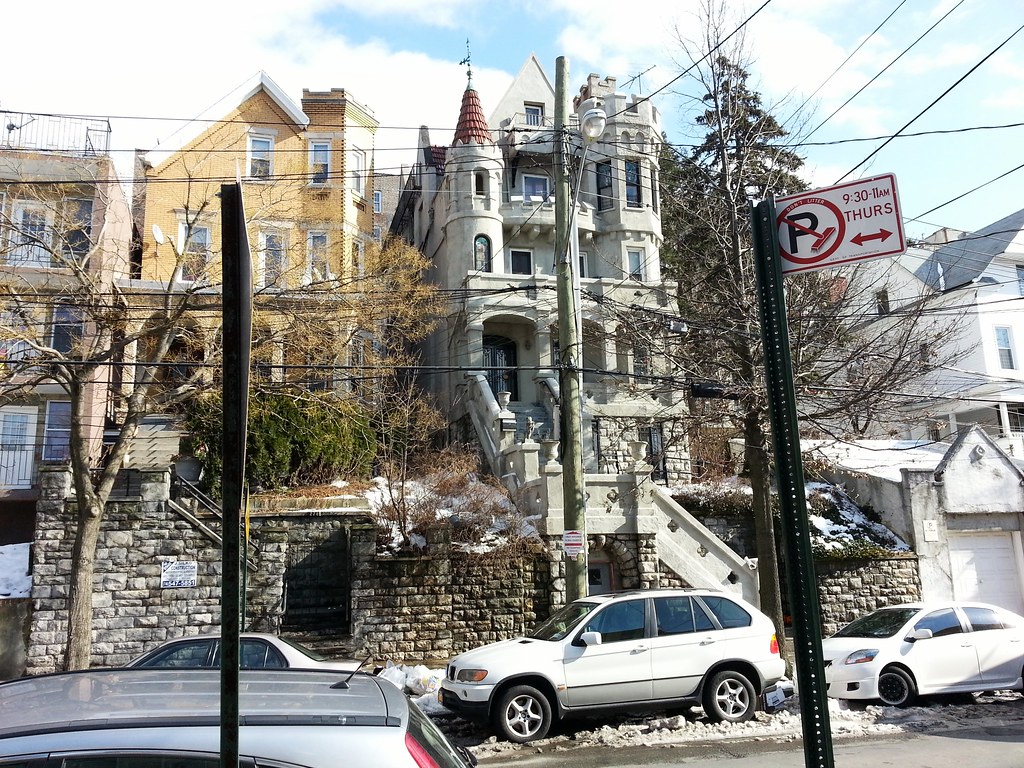
Kevin Walsh of Forgotten New York reports:
This castle redoubt at 2744 Kingsbridge Terrace guarded the realm against invading Riverdalians and the despised Norwooders. Boiling chicken fat was poured through the quatrefoil'd buttresses at any invader who chanced to mount a frontal assault. The castle was erected in 1914.
The AIA Guide to NYC weighs in: Close by the vast veterans' hospital [at 130 W. Kingsbridge Road] is this tiny monument, a stucco castle with numerous gables, balconies, crenellated turrets, a weathervane, a TV antenna, and a tunnel reputedly leading from the "dungeon" to the street.
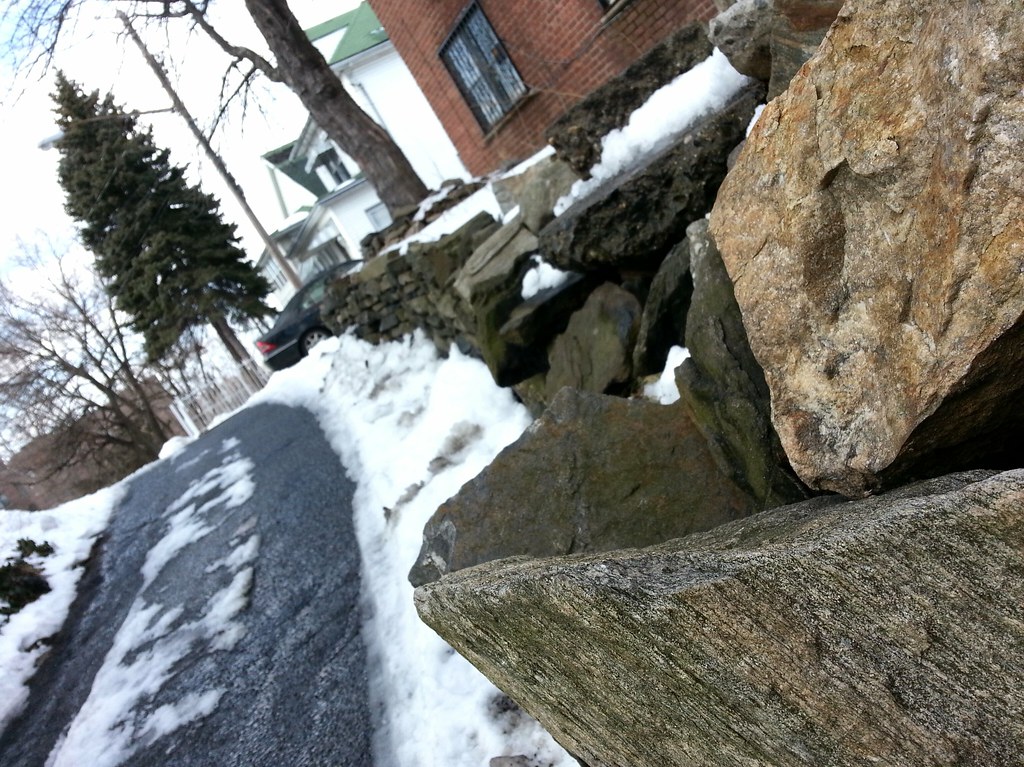
This little dead-end lane does not have curbside garbage pickup, so its residents have to haul their refuse down to Kingsbridge Terrace for collection. A woman who lives on Kingsbridge Terrace right next to Shrady Place (in that red brick house, in fact) told me she had to put up this sign because she kept getting fined by the Department of Sanitation for the sidewalk obstruction caused by all the garbage.
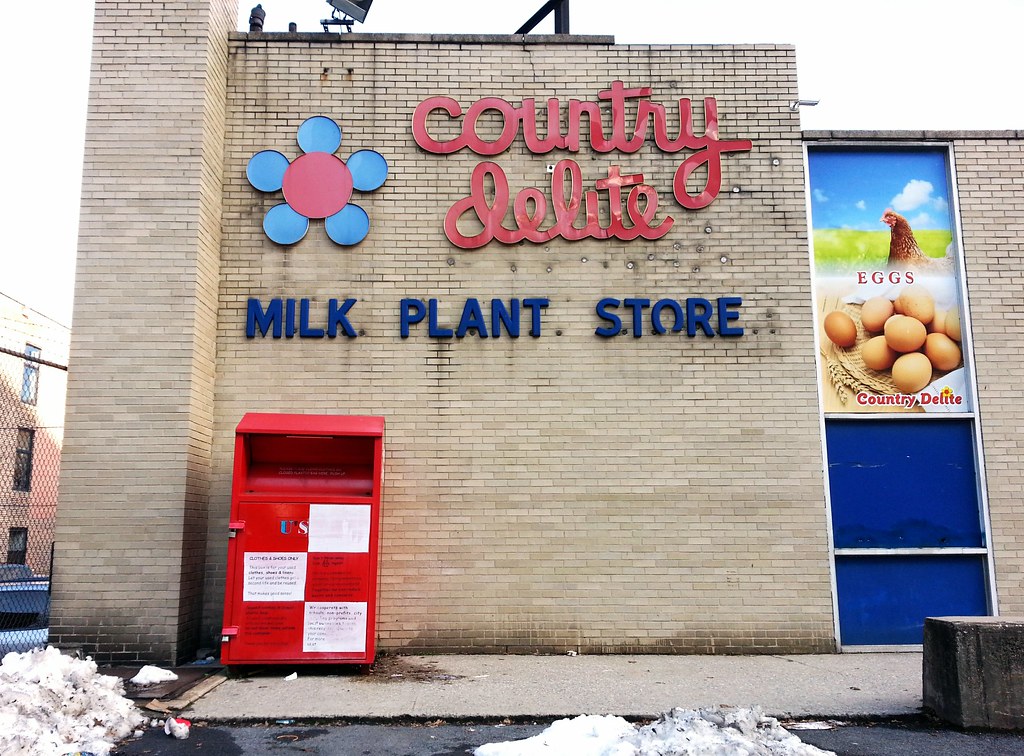
From a 1986 New York Magazine article (be sure to notice the ad featuring Leona Hemsley — one of four on consecutive odd-numbered pages in the issue) about places in the city to take large groups of children for birthday parties and the like:
From behind a glass partition in the Country Delite Milk Plant Store near 230th Street and Broadway in the Bronx, children can watch milk being pumped through pipes into stainless-steel vats, sent from a filtering system to a clarifier and then to a homogenizer, and, finally, poured into plastic containers. Children can spend anywhere from five minutes to half an hour here, and the manager, Mr. Kleinman, is particularly friendly and eager to answer questions.




